Submarine "Shark"
MTK approved the changes. In addition, the project of a small submarine with a displacement of 117 tons, submitted by I. Bubnov, was considered and approved. This boat was armed with two tubular bow apparatus. The basis for starting the development was the conclusions of the MGSH commission that fleet There should be two types of submarines - coastal and cruising. During the ITC meeting, the small submarine project was approved, as well as the changes that were made to the documentation of the 360-ton submarine. The Baltic plant was to build these submarines. General supervision was assigned to the ship engineer Bubnov. On the basis of the resolution of the Minister of the Sea, A. A. Birilev, which followed, the Department of Constructions of the State Administration of Civil Aviation and Construction on February 9, 1906, the order No. 4457 was issued to the Baltic factory, according to which the factory was to build two submarines with a displacement of 20 and 117 tons within 360 months.
From the very beginning, the order to the Baltic plant was financed only by 200 000 rubles. Obviously insufficient amount, which was enough only to deploy preparatory work and begin negotiations with contractors. Factory experts in the summer of 1906, negotiations were conducted with the German company "MAN" (Augsburg), engaged in the construction of diesel engines with a power of 300 hp at that time. for submarines of the French Navy. Such engines also wanted to be created by the L. Nobel plant (St. Petersburg), but this seemed very doubtful, since the company had no experience. Bubnov I.G. 19 August submitted a memorandum to MTC, proposing to change the power plant for the underwater course. Since the proposed 600-strong diesel did not fit into the envelope of the robust hull and had some drawbacks, Bubnov suggested using three 300 hp diesel engines that would work each shaft separately.
Such an unusual project was considered during the meetings of the ITC - 21 August, 22 September and 13 October. The members of the 21 committee of August offered to suspend the construction of the submarine and order one diesel to carry out extensive tests. This decision postponed the adoption of the submarine in order for an indefinite time, in connection with which PF. Veshkurtsev, the head of the Baltic Shipyard, took responsibility for the construction of the 117- and 360-ton submarines on October 13. MTK accepted this offer. In October, the plant presented the MTC technical conditions, the approval of which took place on December 7. This date and should be considered the beginning of the construction of submarines.
In January, 1907 was issued an order for L.Nobel for three 300-strong engines and two 120-strong engines for the Volta (Revel) plant for rowing electric motors. The delivery time of diesel engines - 15 months from the date of order. Batteries for 11 months were to be supplied by French companies "Meto". Hull works were carried out fairly quickly, especially on a submarine with a displacement of 117 tons, which was officially laid by 6 in February of 1906. The small and large submarines of the Baltic 14 plant on June 1907 were enlisted in the fleet lists. Submarines were named "Lamprey" and "Shark".
History the construction of the submarines "Lampa" and "Shark" are similar in many respects, mainly due to similar difficulties in the creation by the "L.Nobel" plant of surface-mounted diesel engines, which largely delayed the entry of submarines into service.
After 22 of the day after the ITC approved the specifications, the Baltic Plant issued an order to the South Russian Dnepropetrovsk Plant for the supply of steel for the submarine hull with a displacement of 360 tons. The first batch of metal mass 1569 pounds 19 pounds (25 tons) arrived 30 March 1907 on the stocks. The work was carried out without endless coordination with various departments and the usual clerical red tape. This was made possible by the decision of MTK adopted by 13 of October in which it said: "... to consider submarines in 1906 and 117 tons experienced, practical construction is provided to be organized by the Baltic Plant ... at the discretion of the plant, and not according to the approved drawings, within those approved. requirements and with the freedom to choose the type and number of engines ..., in addition, the plant must develop ... all the details ... to conduct preliminary tests ... submarines in navigation with their own means until satisfactory change and into the treasury. "
Despite the favorable conditions, the construction was delayed due to the failure to manufacture the engines for the surface run - the L. Nobel plant submitted them for delivery only in March of the 1909 year, that is, almost a year late. The installation of diesel engines and a new rechargeable battery, supplied by the company "Meto" instead of a burned one, took all summer. The installation of diesel engines was monitored personally by I.G. Bubnov, the engineer-technologist G.G. Bubnov. and senior master Ruge G.E.
Submarine "Shark" 22 August 1909, safely descended on the water. At the end of the completion work, the submarine, commanded by Senior Lieutenant Vlasyev S.V., went to Björquet-Zund to carry out preliminary factory tests.
During these tests, the need was identified to replace the electric motor with a more powerful propeller, installation on tubular torpedo tubes of the breakwaters.
Within a month, all deficiencies were eliminated in Kronstadt during docking. During the repeated tests, the new unsuitability of the propellers was revealed - the achieved speed did not exceed the 8,5 nodes in the surface position, therefore it was decided to leave the old screws.
The screws were installed for the third time in the Kronstadt floating dock. October 4 1909, the submarine "Shark" coming out of the dock, was held in Bjørké-Sound for repeated factory tests. Because of the early frosts, the rear admiral of the Chief Inspector of the mine case, Lille V.A. ordered to postpone the acceptance tests until the submarine was transferred to Revel. The submarine "Shark", after a short stay at the Baltic Shipyard, went to Revel from St. Petersburg. In the Marine Channel, the submarine jumped off the course through a flooded barge, but damaged the middle propeller guard and the right propeller. The resulting damage made it difficult to work the vertical steering. However, the troubles during the transition continued: the crank bearing of the left diesel engine burned down, so we had to go further under one medium engine. The submarine on the following wave was so felling that acid spilled from the storage tanks. Despite the stormy weather and the resulting damage, the submarine reached Revel safely, and the acceptance tests were postponed to the spring of the following year.
Specialists of the Revel military port in the winter of 1909-1910 sifted through engines, installed sanitary water pipeline, steam heating system, strengthened periscopes, improved the ventilation of the nasal compartment. At the same time, stability was determined, ventilation, a torpedo loading device, compressors, other mechanisms and systems were tested. At the same time, the Baltic Shipyard manufactured a set of propellers that were installed in the Revel Floating Dock.
"Shark" 15 March 1910 of the year went on to the test. On board was the acceptance committee chaired by the captain of the first rank, the chief of the submarine brigade of the Baltic Fleet, PP Levitsky. Re-determined the stability, capacity and diameter of the circulation of the battery, measured the speed in the underwater and surface positions under the electric motor. July 1 test program had to be interrupted - during the launch of the left diesel engine the base frame broke. The accident was caused by a hydraulic shock, which occurred due to the ingress of water through the gas exhaust pipe into the cylinders.
5 June 1910, the submarine "Shark" carried out the first torpedo firing, after which independently transferred to repair in St. Petersburg. After repairing the damage and returning to Revel, the test program was completely completed.
In the act of 14.09.1911, the acceptance commission, in addition to positive qualities, also noted negative ones: for example, the speeds of surface (11,5 nodes instead of 16) and underwater (6,5 nodes instead of 7) speeds did not satisfy those. conditions that reduced the cruising range, the insufficient capacity of oil tanks and the low metacentric height of the submarine in the surface position (190 millimeters) limited the driving capabilities.
The Commission classified the improved habitability, excellent controllability in different positions, and high seaworthiness. Members of the Mining Department of the MTC, having familiarized themselves with the test report, rendered 26 of October a decision: "... Without waiting for further improvements of the submarine" Shark "and due to the inability to increase the speed of the submarine to the norm specified in the specification and technical tasks, the committee considers itself forced to accept the submarine to the treasury with admission to the current fleet. " However, in the following, the phrase “consider oneself forced” was changed to “believes possible”. The submarine, which became the first in the annals of the Baltic plant, on the basis of this decision 19 November was counted among the ships of the second rank.
The submarine "Shark" in a constructive respect - the further development of the project single-hull submarine, with accommodation in the extremities of the main ballast. A set of robust hull, which was designed for a depth of 45 meters, was formed by concentric steel frames (box construction with dimensions 120 x55 x6,5 x9 millimeters) installed with millimeters 305. The thickness of the nickel plating sheets was 12 millimeters. A sheet of 12 millimeters thick, which to the extremities thinned to 7 millimeters, was additionally riveted to the bottom. The spherical bulkheads on the 30 and 155 frames (12 mm thickness) separated the robust hull from the submarine extremities, which consisted of frames (80X40X6 mm angles) with 4,5-mm sheathing and X-mmX-NNXX mm-wide frames and X-mm X-NUMX-mm shell and 305-X-mm numbered X-mmX-NUMX mm-wide. The conning tower (86-97 frames), designed for maximum depth, was riveted from low-magnetic steel with 12 thick millimeters. A lightweight superstructure was assembled on top of a solid hull to improve seaworthiness (beams and stands made of millimeters 45х30х4 mm, millimeter 305 pitch, mm 3 plating thickness).
The nasal ballast tank (capacity 29,1 tons) occupied the entire nasal tip and was filled through the 280-millimeter blade from the left side of the pump. Siphoning was done through the 157 mm starboard blade. Inside the tank there were nasal tubular torpedo tubes, storages for spare torpedoes, a trim tank (1,3 ton capacity), a nosepiece horizontally rudders. Aft trim and ballast tanks had a similar device and differed only in capacity (1,2 and 26,1 tons). In the stern and fore parts of the submarine, waterproof doors were provided for inspecting mechanisms and tanks in spherical bulkheads. According to the project, in the tanks themselves, which were intended to accommodate part of the personnel while sailing in a surface position, portholes were carried out.
In the lower middle part of the robust hull (85-99 frames) there were two tanks (each 6,4 tons capacity), and, like on the Minoga submarine, the bow served for urgent diving and ascent, and the stern - for equalization. Medium tanks were filled with their individual Kingston. In the superstructure, in the stern and in the nose from the conning tower (97-127, 57-86 frames), there were two deck tanks (capacity of each 18 tons), which were filled with gravity drain when the ventilation valves were opened. Their drives and kingston medium ballast tanks were put into the conning tower.
About 100 tons of ballast were used for the transition between surface and underwater positions. During the ascent, the differential and medium tanks could be blown at the maximum depth with compressed air. In the end tanks, the water was pumped out by two reversible centrifugal pumps of the Maginot system (depending on the depth of immersion, the capacity was 10-362 tons per hour) installed in the aft and bow compartments. They were connected to the middle and differential tanks in the pipeline. There were also additional manual and electric bilge pumps. A completely reliable system was provided for immersion in 3 minutes.
In the lower part of the nasal compartment (frames 30-74) there was a rechargeable battery (capacity 5050 Ah), which consisted of 126 elements of the "Meto" system. The battery top was covered with wooden flooring, which served as the deck of the nasal compartment. The hold also housed 13 air ducts, one of which was designed for firing from torpedo tubes. The lockers were installed on the flooring, the covers of which served as the resting places of the team members. A galley with a refrigerator, as well as various auxiliary mechanisms were located on the starboard side. An electro-compressor, a bilge pump and a wash basin were placed on the left side. The middle part of the submarine (74-87 frames, in the nose of the conning tower) was occupied by officers' premises, which consisted of a mess-room and three cabins, under the deck of which were tanks for fresh water. Directly under the conning tower (87-97 frames), tank tanks were placed onboard (total capacity 17 tons). In this case, consumable fuel was replaced by seawater. Before the spherical bulkhead, the entire aft section was reserved for the engine room with three 300-strong 4-cylinder reversible diesels operating on a separate shaft (piston stroke 380 millimeters at 350 rpm, cylinder diameter 330 millimeters). A 300-strong electric motor was placed in the median plane, which was used as a rowing engine for underwater travel or a dynamo machine. For use as a dynamo, it was connected via a friction clutch with an average diesel engine.
During operation, the lack of such an arrangement of the main mechanisms was revealed. When "sinking" astern during the dive (this often happened on submarines of the Bubnov IG construction) and hitting the ground with a vertical rudder fence, the mean gross line was wedged, therefore the Shark submarine could move only under extreme diesel engines in the surface position. To clear advantages over the submarine "Lamprey" is the presence of reversing devices that allow you to change the course without removing the load. This greatly improved the maneuverability of the submarine. It was also possible to increase the cruising range due to the additional oil reserve, which was taken on board and was stored in the aft ballast tank. The submarine "Shark" in the submerged position was controlled by two pairs of horizontal stern and bow rudders with an area of 4 and 7,4 м2, respectively. The posts (as on the submarine "Lamprey") were located in the extremities, which did not allow for the reloading of torpedo-tubes in a submerged position - the horizontal-level steering interfered. The vertical wheel (area 4,2 м2) was controlled by the steering wheel in the conning tower and on the bridge. The submarine's armament consisted of four tubular torpedo tubes (two at the stern and one at the bow) and four spare 450-millimeter torpedoes, as well as four Dzhevetsky-Podgorny torpedo tubes that were installed in the superstructure cut-outs. Visual observation was carried out through 5 portholes of the Hertz system retractable periscopes made in the conning tower and 2 (length 5 m, rise time 20 seconds).
The submarine "Shark", despite the shortcomings, became an important stage for the development of domestic submarine shipbuilding - the first submarine capable of solving defensive tasks and acting on long-distance communications. It is not by chance that 11 March 1911 of the year during the discussion in the MTC of the project of a submarine with a displacement of 630 tons of construction Bubnova I.G. (subsequently the types of "Leopard" and "Walrus") directly indicated that the submarine "Shark" was the prototype. Therefore, it was proposed to conduct additional tests of the submarine to clarify the maneuvering characteristics and stability in different positions. Samples ending 25.04.1911, confirmed the design characteristics of the new submarines.
Submarine "Shark" at the beginning of the First World War was one of the few submarines of the Baltic Fleet that were able to operate off the coast of the enemy. This largely determined the further intense combat service of the submarine.
In the evening of December 4 1914, the submarine "Shark" was in the open sea. A snowstorm rages, the wind speeds through compressed snow - the winter Baltic storms. Moments visibility was almost zero. At this time, the submarine commander, captain of the second rank, S.N. Vlasyev, the watch officer, the midshipman Terletsky, KF, were on the bridge. and non-commissioned officer steering Paste Ivan. The waves overwhelm the submarine, but it stubbornly moves forward as Vlasyev searches for enemy ships. Before going to sea, the commander of the submarine at headquarters said: the German cruiser "Augsburg" was noticed, which is a tempting target. Here comes the submarine "Shark" on the surface, although under similar weather conditions it was necessary to dive for a long time.
Seeing something through the snowy darkness is almost impossible. But no, it turns out to be possible! - "To the right is a ship! From twenty to twenty-five cables to it! Moving on a heading course!" Ivan Paste, who is one of the best signatories of the Baltic Sea and only recently produced non-commissioned officers for his services, and this time did not lead. “Well done,” the commander replies, peering into the distance. “I see!” Augsburg! ”To everyone down!” Terletsky and Paste dived into the hatch. Before following them, Vlasev swept the snow off the periscope head with a mitten. However, the snowstorm intensified every minute. Coming down to the wheelhouse and having closed the hatch, the commander put a periscope eyepiece, but did not see anything. The lenses were instantly covered with snow. The boat is blind. Is it possible to attack in these conditions? “Konstantin Filippovich, what are we going to do?” Asked the commander of Terdetsky and, not waiting for the watch officer to answer, said: “There is only one way out: you need to climb the bridge again, the submarine is in a positional position, I will command from above. There will be a helmsman. Come on! "
Pumps rustled. The submarine "Shark" began to take water into the end tanks. For a long, long time, the first submarines of IG Bubnova sank. - 3 minutes - and therefore the commander decided to bring the submarine into a positional position, when only one cabin was left above the surface.
On immersion in this case only one minute will leave. Even if an enemy cruiser finds a Russian submarine, which is very doubtful under these conditions, she will have time to dive.
Having opened the upper hatch, Vlasyev and Terletsky again took their place on the tiny bridge, the lion's share of the area of which was occupied by the thumbs of two periscopes. Both the sky and the sea fell on the officers. The snow was blowing by a hurricane wind, the bridge was violently stormed by the waves. The bridge was flooded both in the traveling position and during the positional position when it was almost flush with the surface of the sea; practically nothing protected officers from the impacts of the waves. They went on the attack almost "riding" on the boat. At the slightest mistake of the helmsman-horizontallychik - the submarine is buried in the nose, and the officers will be washed overboard. Once on the submarine Pescari the same thing happened. The tug stop (the submarine was towed), the helmsman’s miscalculation, and as a result, the commander and mechanic who were on the bridge found their grave in the waves. Terletsky and Vlaiyev remembered this incident. However, it was the July heat, and this time - December, a blizzard, a frost. On the bridge of the submarine "Shark" in the middle of the roaring sea in bravery two competed. They competed. And there was a reason for that ... At that moment, Vlasyeva’s wife, John Alexandrovna, who was loyally loved by Terdetsky, seemed to be next to them. Vlasyev knows this, but he does not have any hostility towards his subordinate: in his heart another woman took the place of John Alexandrovna. The gap is already inevitable, but Vlasyev is not indifferent who will bring up his children - two sons and a daughter. Already decided that the children will stay with the mother. The commander and Terdetsky have long been acquainted, he is confident in him, but he cannot once again check the qualities of the person whom the Vlasyev children will call a stepfather. Therefore, not only military necessity made the submarine commander take a desperate step and go on the attack “on horseback” on a submarine.
Wave after wave rolls onto the boat ... Water flows through the open hatch. Very bad. A submarine receives excess water precisely when it is taken into account and precisely balanced in tanks. “This is bad,” Vlasyev shouted. “We will drown the boat. You need to close the hatch!” - "And how to communicate with the cabin?" - Terletski shouted almost into the very ear of the commander, as the sea simply roared. - "We will give commands through the upper vent valve, the benefit is now open. To batten down the hatch!" Order commander Terletsky executed. German cruiser approaching. His silhouette suddenly appeared, a blizzard, as if having exhausted anger, took a breather, then disappeared again in a snowy shroud. Start torpedoes! However, they passed by. In the report, Vlasyev reported: “The probable causes were the following: poor aiming due to low visibility, a changing blizzard, and the fact that, staying at the top, the main attention had to be paid to rolling waves did not wash overboard, - during the shot I barely had time to grab the handrails. "
The report will include the following entry: “I consider it my duty to commend the dedication of the officers and crew during the voyage under such difficult conditions ... it is also necessary to note the dedicated and useful activity of the midshipman, watch officer, Terletsky, an outstanding officer in all respects, deserving in capacity, character and knowledge of the special difference in the service. "
Soon, John Alexandrovna took the children and went to Terletsky from Vlasyev. The unwed ones (they had not yet decided to divorce by agreement), they lived in Reval together. But Terletskiy receives in command a submarine “Okun” based on the Aland Islands. Joanna Alexandrovna at the end of November 1916 went to Aland to visit Terdetsky. A few days flashed quickly. Terletsky December 1 spent John Alexandrovna on the transport "Shiftet", heading for Revel, and he went to the harbor, because the battle was coming.
The morning mist stood like a curtain, revealing the pines and granite of the Aland Islands. Terletsky led the submarine "Perch" from the harbor. "Shifett" went in several cables. From the bridge, Terletsky viewed the steamer with binoculars. It seemed to him that he sees John Alexandrovna at the stern. After all, she knew that Konstantin Filippovich would go for some time, until the moment of immersion, in the wake of the steamer. And suddenly - under the stern of transport a burst of fire. A blast wave came to the submarine and the Perch lay aboard. Transport, vzdybivshis nose, almost instantly sank. And here again there was a deaf rumble - the steamer boilers exploded in the icy water. John Alexandrovna among the few saved was not.
From the report of the commander of the Fifth Separate Artillery Company of the Primorsky Front Abo-Aland position.
02.12.1916: “In 09: The 35 steamer coming from Marienhamn covered thick smoke and objects were seen flying in different directions. Then a faint sound of an explosion. Only three seconds later, only sinking food was visible, and after 10 seconds everything sank into water. "
From the list of those killed on the ship "Shifett":
Boatsmanmat, steering perch "Okun" Sergey Ivanov, who accompanied the wife of the captain of the second rank Vlasyev.
Individuals and civil ranks:
...
9) Wife of the second rank captain Vlasyev ...
The death toll included 65 people. Approximately 10 people survived, but one died on the way to Marienhamn. So died Terletsky's beloved woman. Two of the three children Vlasyev (at this point the eldest son entered the Marine Corps) remained in the hands of the commander of the Okun submarine Terletsky KF In memory of John Alexandrovna, he was deeply faithful, and Vlasyev’s children were under Terletsky’s care for a long time. The younger son, Rostislav, for decades considered him to be his father, not noticing the difference in relation to himself and to Boris, the native son of Terletsky from his second marriage. Tankman Lieutenant Boris Boris died a brave death at the beginning of the Great Patriotic War.
In the winter of 1914-1915, during repair, an 47 caliber gun was installed in the nose of the superstructure. Since the Baltic Fleet did not have submarine minelayers for special construction, the Akula submarine was equipped with a device for transporting and delivering four mines used by the Black Sea Fleet’s Krab submarine minelayer by the autumn of 1915.
Mines were fastened in the nests with yoke behind the deckhouse on the upper deck, and after the release of marching mounts manually rolled over the inclined brackets overboard. Practical tests conducted at Revel raid gave positive results. November 14, 1915, the commander of the submarine captain of the second rank Gudim NA led the submarine "Shark" in the seventeenth since the beginning of the war, a military campaign for the production of mines south of Libau.
In the evening of November 15 1915, the submarine "Shark" was seen from the coastal posts near the coast, where the ship was sheltering from the storm. This is the latest information - the circumstances of the death of the submarine "Shark" remain a mystery to this day.
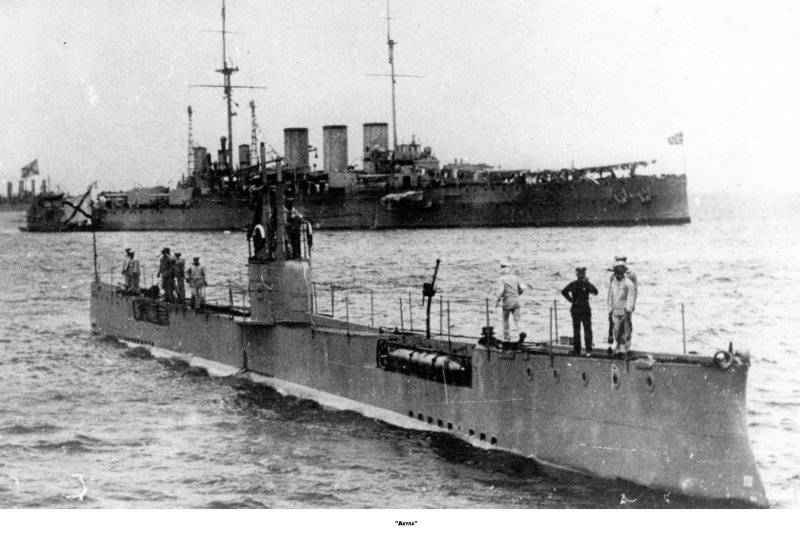
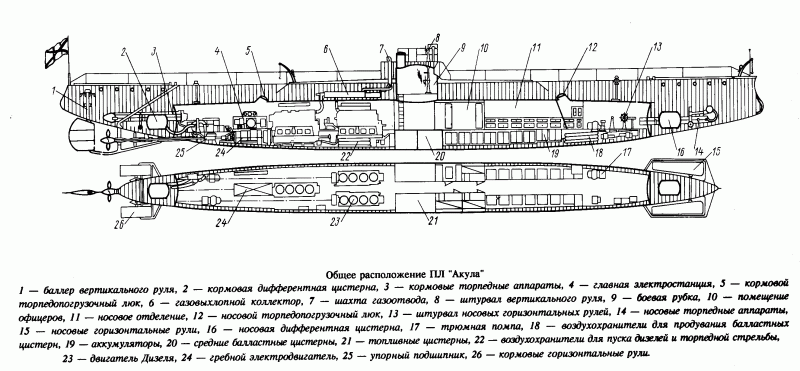
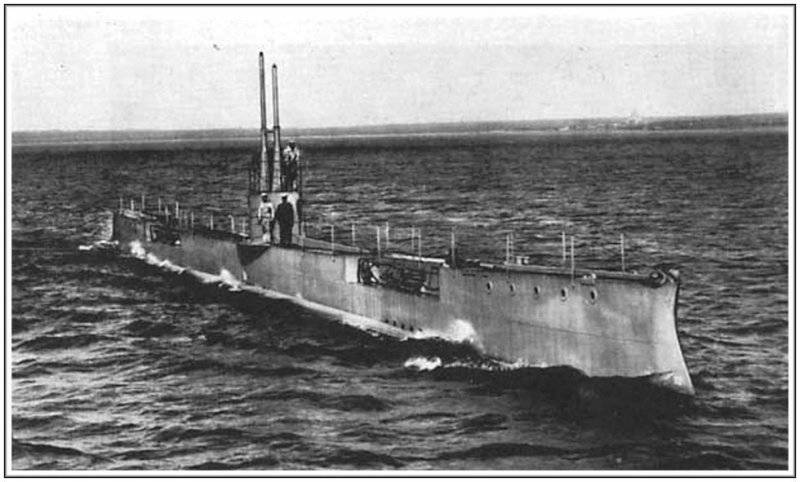
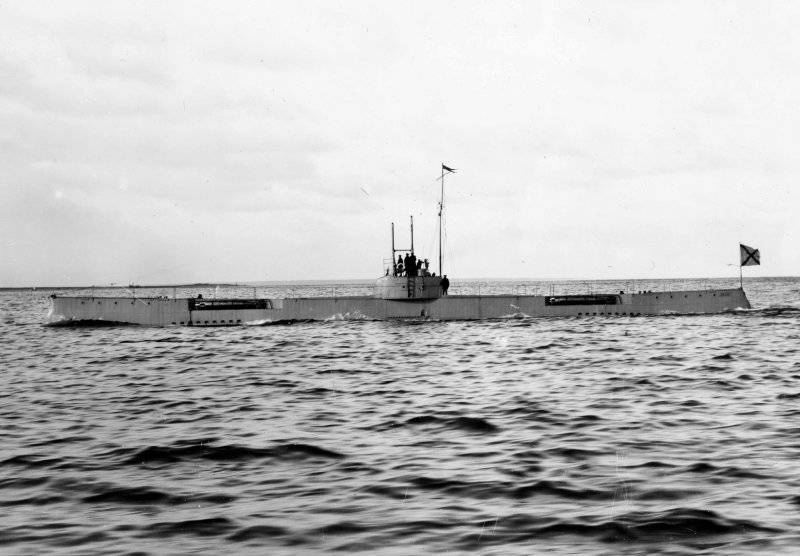
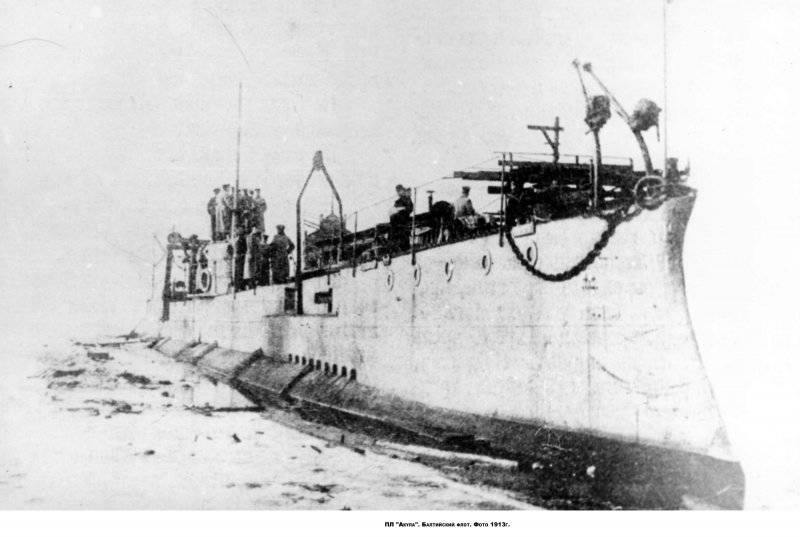
Information